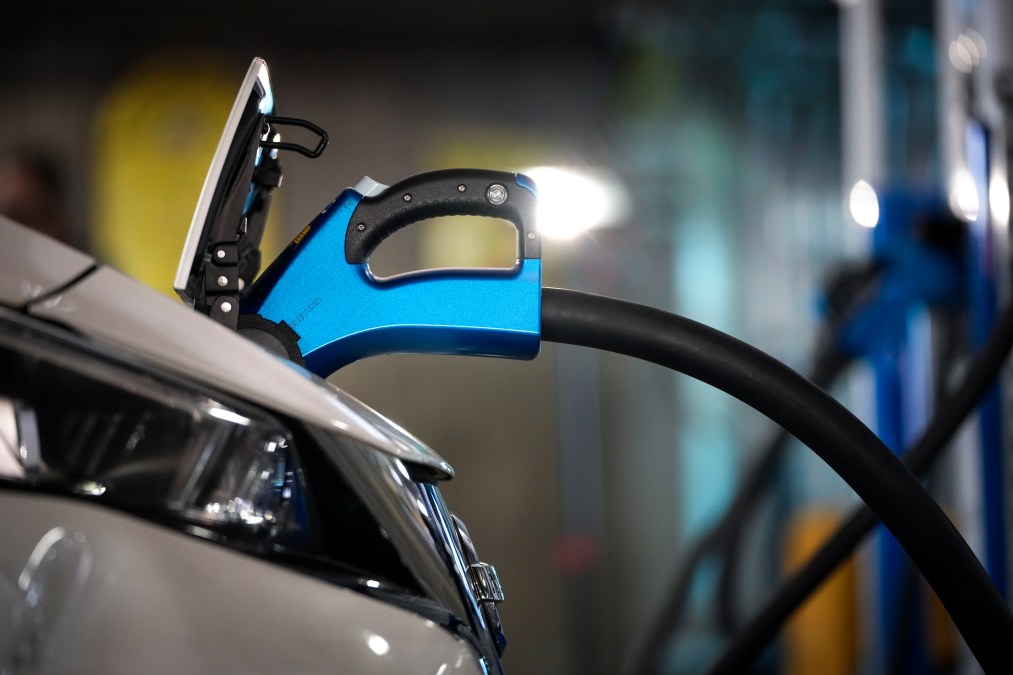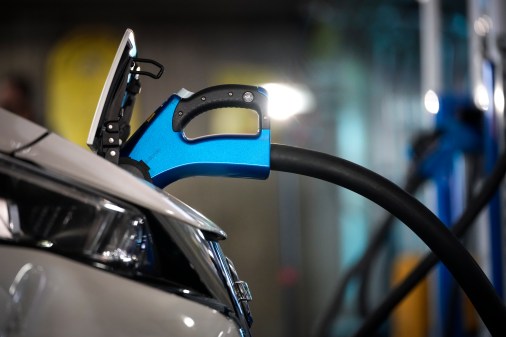The tech behind the nationwide charging network is top of mind for this Biden official

To accelerate the adoption of electric vehicles, the Biden administration is racing to build a network of EV chargers across the United States. These chargers will play a pivotal role in combating range anxiety — the concern some drivers have that when traveling long distances, they could end up stranded without somewhere to plug in.
It’s an ambitious goal: Thus far, six charging stations funded by the National Electric Vehicle Infrastructure (NEVI) Formula Program have been built across the U.S., including in New York, Ohio, and Pennsylvania, while four other states have since broken ground and 18 more have shared conditional or final awards. That’s a noted increase from December, when there were zero built, according to Politico. And, the number of charging ports in the U.S. has grown from around 100,000 in the last quarter of 2020 to nearly 175,000 today, according to the Alternative Fuels Data Center, an online resource created by the Department of Energy. The eventual objective is to fund 500,000 chargers nationwide.
Technology standardization will play a role. To get all of these chargers up and running, the devices not only need to be manufactured and installed, but also designed in a technically cohesive way. Charger plugs will need to work with a wide range of vehicles. Devices within the chargers will also need to log and track their uptime — particularly so that drivers know which chargers are actually online and working. And when the chargers do break, they’ll benefit from common error codes so that there is a universal way of identifying issues.
There’s exciting work to address these challenges in the works, says Gabe Klein, the executive director of the Joint Office of Energy and Transportation, which serves as a hub for the government’s electric vehicle work. In a recent interview, Klein described the progress being made, including a Federal Highway Administration request for information focused on a connector standard, work on the ChargeX private-public partnership, and efforts to address some of the cybersecurity challenges raised by building an EV network.
This will be critical, he argues, as EV chargers come online to support the growing number of electric cars on the road. The Biden administration is aiming for 50% of new cars sold to be electric by 2030.
“Our job in the federal government is to be really catalytic. We saw a trend in the way things were going and we’re catalyzing that trend. The EV charging network is absolutely crucial,” Klein told FedScoop. “We’re making a tremendous amount of progress in a very small amount of time. Since the president’s taken office, this is where you’ve seen these gigantic increases in both vehicles, as well as charger numbers.”
Editor’s note: The transcript has been edited for clarity and length.
FedScoop: Where do we stand on electric vehicle uptake right now in the U.S.? The Energy Information Administration reported that more than 16% of light-duty vehicles purchased last year were electric or hybrid. Is that fast enough for the goals of the administration?
Gabe Klein: We had a huge year for EV uptake last year. … It depends on which source you reference, but about [1.4 million electric vehicles last year] were sold. That’s a huge increase. It’s the first time we’ve ever broken a million. … We’ve even continued to see strength in January.
FS: Obviously, those are all really exciting numbers. There’s this charging network that you’re working on that’s supposed to help accelerate that even further. I think our readers are probably curious about the extent to which — once the network is built — the federal government will be involved in that. Should I be thinking about a federal government app that tells me where all the chargers are on this network?
GK: Our job in the federal government is to be really catalytic. We saw a trend in the way things were going and we’re catalyzing that trend. The EV charging network is absolutely crucial. … When we think about our impact between the bipartisan infrastructure law, the Inflation Reduction Act, and the president’s entire clean energy agenda, it’s all coalescing, right? We’re seeing tremendous investment from the private sector as well.
We’re tracking the entire increase. I’m just looking today on our website: We’re at 173,463 ports and 66,330 station locations, which is pretty amazing. I think we’ve got about 111,000 gas stations. So we’re making a tremendous amount of progress in a very small amount of time. Since the president’s taken office, this is where you’ve seen these gigantic increases in both vehicles, as well as charger numbers.
We’re not going to have a federal app. We are going to collect all the data. If you go to our website … you can see every day, multiple times a day, you can see updates to the charger numbers. We are designing something called EV-ChART. EV-ChART is where any Title 23-funded charger, the data will be submitted and you’ll be able to get basic information about that charger.
There’s also a public API that was mandated by Congress — that is not feeding into our EV-ChART system, necessarily — so that all these chargers put out information in real time on whether they’re available or not, what connection they have, how fast they charge …
FS: So the API is going to be pushing that data into whatever other charging network app someone is already using?
GK: Exactly. And these companies want their information out in those apps because they want people using their charging network. [Editor’s note: A DOE spokesperson shared after publication that “there is an app or mobile web option available from the AFDC that can be used to find chargers. Drivers can also use their preferred charging or map app to find places to charge.”]
FS: Another thing I wanted to talk about is the recent Federal Register posting about the J3400 connector. How optimistic are you that other manufacturers are going to adopt that technology?
GK: Just to give you a little history: Going back to November of 2022, Tesla announced they were gonna open source their standard, which is called NACS. Then in February, we put out minimum standards with [the Federal Highway Administration] here in the federal government …
We really facilitated the ability for industry to coalesce around whichever standard they wanted. And industry decided to coalesce around what was at that point the NACS standards. What we did quickly worked with SAE International, which is one of the premier standards organizations, to create J3400, which is a true open charging standard.
Since then, quickly, basically every automaker for the most part, has announced that they are going to adopt J3400. … We’re here very much as a facilitator and we want industry to coalesce and we want to make sure that customers are protected ultimately in the process. … You’ll actually see the manufacturing of the J3400 inlet in vehicles probably starting in a little over a year.
FS: I know that something the ChargeX consortium is working on is standardizing charger error codes. What is the benefit of standardizing error codes? Why does that matter and why would that be helpful for chargers?
GK: The joint office was put together very quickly with recognition that we need to cut across government and to break down silos and work as fast as humanly possible on behalf of the public to electrify and make sure that clean fuels were available as this massive change happens, not just in our country, but worldwide. … The ChargeX consortium was spun up in a matter of months in response to a need. We have, I believe, 80 companies plus now, that are part of it. It’s a public-private partnership between three national labs and these companies, with support from the joint office. …
We identified the largest barriers to having the most usable and reliable network in the current network. …
Minimum required error codes were a problem because you’ve got manufacturers for chargers, you’ve got [original equipment manufacturers], you’ve charging station operators, and they’re all using different messages to report similar errors. The new common codes that were put out by ChargeX are going to simplify the diagnostics when a charging network fails and will, overall, improve charging network operations and the experience for drivers. It’s going to simplify everything so that all these companies — whether they are manufacturers or operators — they’re all speaking the same language.
FS: What else are you encouraging the industry to standardize right now?
GK: …Payment systems were identified as a big potential issue. And the more I dug into it, the more I found that the combination of a payment system with a communication system was definitely a rich area for potential failure.
Just in the last couple of weeks, ChargeX released a report about best practices for payment systems at publicly available charging stations. … You might have swipe or tap-and-pay. It proposes industry supported solutions for different payment issues, including network issues, robustness and hardware issues, integration, activation, installation issues, maintenance issues.
Overall, the goal of the payment report is to help the EV charger stakeholders to troubleshoot failures and establish reliable payment processing systems. In many cases, it means simplifying these systems.
FS: How are you thinking about the cybersecurity of this network? There’s the potential for people to look at this as an attack vector against the U.S.
GK: I remember one of my first charging experiences at one of the larger networks was playing through a charger and seeing a [denial-of-service] prompt on the screen. Obviously, that concerned me for a few reasons. One is, obviously the charger was not functional. But, two, I thought to myself as someone who works in tech and business, was ‘wow, that seems like something that would be open to hacking.’
We’re really like the center of gravity for coordinated cybersecurity efforts for EV charging across the federal government. … The joint office cyber mission is to fully execute projects in 12 months or less, which are directly applicable to the [NEVI] minimum standards and are going to impact EV-critical infrastructure. …
We’re doing a combination of tactical projects that are based on rapid industry consensus, like short-term security issues. We’re also supporting the Office of the National Cyber Director at the White House on implementation of the administration’s national cybersecurity strategy.
We’re looking forward to what the issues are going to be, potentially, in the years to come and partnering with the labs on that. When it comes to the states and cities that are actually going through procurements right now, we’re partnering [the Pacific Northwest National Laboratory] and [Idaho National Laboratory] to develop sample cybersecurity procurement clauses to assist these agencies in writing RFPs and making sure they’re future-proofing not just their agreements and contracts, but the actual hardware and software that they’re buying.
This story was updated March 19, 2024, to correct the number of EVs sold in 2023, clarify that the NEVI-funded facilities are charging stations, and add background from a DOE spokesperson on a charging network app.


